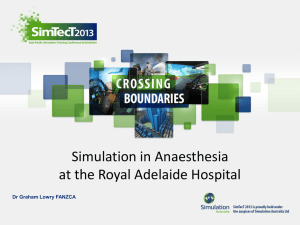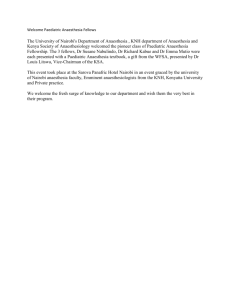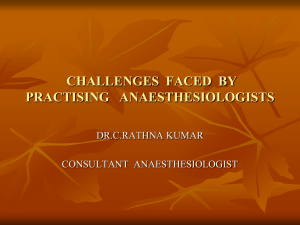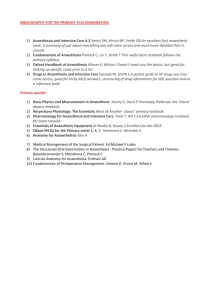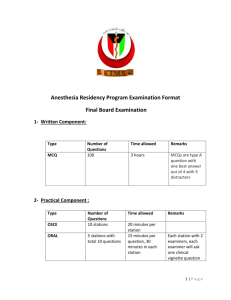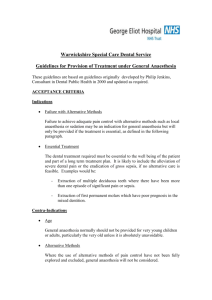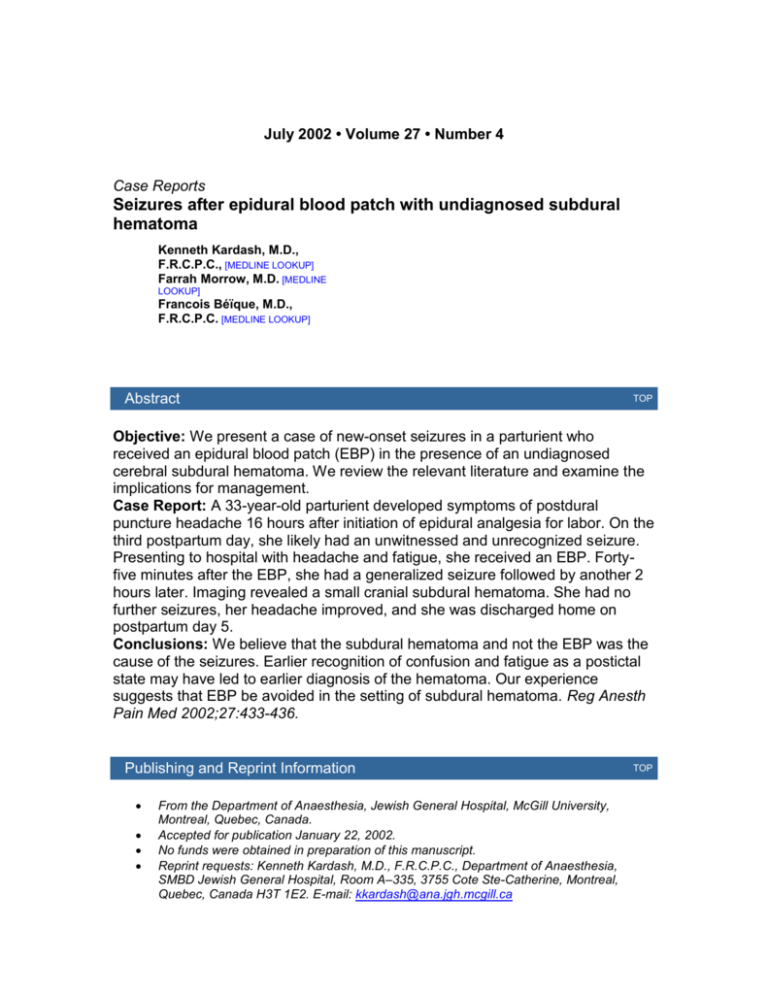
July 2002 • Volume 27 • Number 4
Case Reports
Seizures after epidural blood patch with undiagnosed subdural
hematoma
Kenneth Kardash, M.D.,
F.R.C.P.C., [MEDLINE LOOKUP]
Farrah Morrow, M.D. [MEDLINE
LOOKUP]
Francois Béïque, M.D.,
F.R.C.P.C. [MEDLINE LOOKUP]
Abstract
TOP
Objective: We present a case of new-onset seizures in a parturient who
received an epidural blood patch (EBP) in the presence of an undiagnosed
cerebral subdural hematoma. We review the relevant literature and examine the
implications for management.
Case Report: A 33-year-old parturient developed symptoms of postdural
puncture headache 16 hours after initiation of epidural analgesia for labor. On the
third postpartum day, she likely had an unwitnessed and unrecognized seizure.
Presenting to hospital with headache and fatigue, she received an EBP. Fortyfive minutes after the EBP, she had a generalized seizure followed by another 2
hours later. Imaging revealed a small cranial subdural hematoma. She had no
further seizures, her headache improved, and she was discharged home on
postpartum day 5.
Conclusions: We believe that the subdural hematoma and not the EBP was the
cause of the seizures. Earlier recognition of confusion and fatigue as a postictal
state may have led to earlier diagnosis of the hematoma. Our experience
suggests that EBP be avoided in the setting of subdural hematoma. Reg Anesth
Pain Med 2002;27:433-436.
Publishing and Reprint Information
From the Department of Anaesthesia, Jewish General Hospital, McGill University,
Montreal, Quebec, Canada.
Accepted for publication January 22, 2002.
No funds were obtained in preparation of this manuscript.
Reprint requests: Kenneth Kardash, M.D., F.R.C.P.C., Department of Anaesthesia,
SMBD Jewish General Hospital, Room A–335, 3755 Cote Ste-Catherine, Montreal,
Quebec, Canada H3T 1E2. E-mail: kkardash@ana.jgh.mcgill.ca
TOP
© 2002 by the American Society of Regional Anesthesia and Pain Medicine.
Best Practice & Research Clinical Anaesthesiology
Tables of Contents and Abstracts Online Issue Contents
Paediatric regional anaesthesia - what makes a difference?
John B. Eck[ast], Allison Kinder Ross
p 159-174, Volume 16, Number 2, June 2002
Abstract
Regional anaesthetic techniques are useful for providing post-operative pain control for
ambulatory surgery in children. This chapter focuses on unique features of paediatric anatomy
and physiology that allow successful performance of these techniques. An overview of the
effective use of long-acting local anaesthetics in children is presented. Combinations of local
anaesthetics and adjunct medications that prolong caudal blockade, the most commonly
performed paediatric block, are reviewed, with a goal of providing prolonged analgesia with
minimal side-effects. An overview of the use of peripheral nerve blockade and specific
recommendations for the use of these blocks in children is also presented. Copyright 2002
Elsevier Science Ltd
Keywords
regional anaesthesia; caudal; peripheral nerve block; paediatric anaesthesia
International Journal of Obstetric Anesthesia
Tables of Contents and Abstracts Online Issue Contents
Haemodynamic changes caused by oxytocin during caesarean
section under spinal anaesthesia
A. J. Pinder, M. Dresner, C. Calow, G. D. Shorten, J. O'Riordan, R. Johnson
p 156-159, Volume 11, Number 3, July 2002
Abstract
The haemodynamic effects of oxytocin receive scant attention in pharmacology texts, but may be
clinically significant in vulnerable patients. Despite prescriber information recommending a dose
of 5 international units by slow i.v. injection, it is the authors' experience that it is very common
practice in the UK to give 10 units as a rapid injection. We therefore conducted a randomised,
double-blind study of the haemodynamic changes induced by rapid bolus of 5 or 10 units of
oxytocin in 34 healthy term parturients at caesarean section under spinal anaesthesia. There was
a small but statistically significant (P <= 0.05) reduction in mean arterial pressure from baseline
30 s after a 10-unit bolus. However, large, statistically significant increases in heart rate and
cardiac output occurred 1 min after 5 units and 2 min after 10 units. These changes peaked 1 min
after oxytocin administration and were greater in the 10-unit group (P<= 0.05). The importance of
these findings is that some women with hypovolaemia or cardiac disease may be unable to
mount these compensatory responses and are therefore at risk of haemodynamic collapse after
oxytocin boluses. This has been illustrated by a maternal death reported to the Confidential
Enquiries into Maternal Deaths in the United Kingdom. The need to adhere to a dose regimen of
5 units by slow injection needs re-emphasis, but no evidence exists to claim that even this will be
haemodynamically inert. We therefore recommend that oxytocin boluses be avoided in women
with hypovolaemia or cardiac disease. Copyright 2002 Elsevier Science Ltd. All rights reserved.
Source: University Of Illinois At Chicago (http://www.uic.edu/)
Date: Posted 7/18/2002
Aspirin's Target, The COX-2 Enzyme, Linked To
Cancer Of The Uterus
A researcher at the University of Illinois at Chicago College of Medicine has discovered
a link between cancer of the uterus and the COX-2 enzyme, a compound first implicated
in the painful inflammation associated with arthritis and more recently in the spread of
colon cancer.
Nationally, cancer of the uterus is the most common cancer of the female reproductive
system, accounting for 6 percent of all cancers in U.S. women.
In a laboratory study, Dr. Serdar Bulun, director of reproductive endocrinology and
infertility and a member of the UIC Cancer Center, cultured malignant epithelial cells
from the lining of the uterus alongside normal cells from the same kind of tissue.
In the interaction between normal and malignant cells, the malignant tissue induced the
normal tissue to increase production of the enzyme cyclooxydase-2 (COX-2). Levels of
certain prostaglandins also rose, hormone-like substances synthesized by COX-2.
As Bulun and other researchers have shown, COX-2 and its product prostaglandins set
off a cascade of molecular events, including an abnormal increase in estrogen, that leads
to tumor growth.
"The findings suggest that everyday drugs like aspirin or ibuprofen -- nonsteroidal antiinflammatory drugs that block the COX-2 enzyme -- might be tried as treatments for
uterine cancer in combination with other therapies," Bulun said.
Results of the study will be published in the July 17 issue of the Journal of Biological
Chemistry.
The prostaglandins synthesized by COX-2 are mediators of inflammation, the body's
response to injury characterized by increased blood flow to the tissue, increased
temperature, redness, accumulation of immune cells and pain.
Bulun has found increased levels of COX-2 and its product prostaglandins in
endometriosis, a painful, inflammatory disease in which endometrial tissue from the
lining of the uterus attaches to other organs, including the ovaries, fallopian tubes, and
sometimes the gut and rectum, causing internal bleeding, chronic pelvic pain and even
infertility.
COX-2 and prostaglandins are also involved in the spread of tumors, such as in colon
cancer. They reduce the rate of cell death, increase the invasiveness of the malignancies
and promote the growth of blood vessels that deliver nourishment to the lesions.
Currently, drugs that inhibit COX-2 are prescribed in the treatment of precancerous
polyps in the colon and colon cancer, where cells have increased levels of the enzyme.
In previous research, Bulun found that the prostaglandins manufactured by COX-2
stimulate the production of estrogen. Cancer of the uterus, as well as certain kinds of
breast cancer and endometriosis, depends on estrogen for fuel, and estrogen itself drives
the manufacture of prostaglandins.
"You see how crafty this cancer is," Bulun said. "By encouraging the production of COX2, it sets in motion a continuous cycle whereby the tumor can thrive and grow."
In two additional articles published in the July issue of the Journal of Clinical
Endocrinology and Metabolism, Bulun demonstrates that two other molecules also
increase production of COX-2. One molecule, called vascular endothelial growth factor,
is involved in promoting the growth of blood vessels that feed the growing pathological
tissue. The other molecule, interleukin-1beta, is a small molecule associated with the
immune system, which deploys cells to sites where foreign tissue has invaded.
"These findings suggest that cancer of the uterus finds multiple ways of ensuring its
survival," Bulun said.
For more information about the UIC Cancer Center, see http://www.uic.edu/com/cancer.
For more information about UIC, see http://www.uic.edu
Note: This story has been adapted from a news release issued by University Of Illinois
At Chicago for journalists and other members of the public. If you wish to quote from
any part of this story, please credit University Of Illinois At Chicago as the original
source. You may also wish to include the following link in any citation:
http://www.sciencedaily.com/releases/2002/07/020718075705.htm
Anaesthesia
Volume 57 Issue 8 Page 756 - August 2002 The effect of a pre-operative infusion of
Ringer's solution on splanchnic perfusion in patients undergoing coronary artery bypass
graftingT. F. Klein,1 C. Osmer,2 M. Müller,3 A. Junger,4 H. Akintürk5 and G.
Hempelmann6
Summary Surgical patients develop a fluid deficit during pre-operative starvation. This
study examines the effects of pre-operative fluid administration on haemodynamic
variables, oxygenation and splanchnic perfusion in patients undergoing elective coronary
artery bypass grafting. Forty-eight patients were randomised to receive either a preoperative crystalloid infusion (crystalloid group, n=24) or no infusion (control group, n=
24). Patients in the crystalloid group received a continuous infusion of Ringer's solution
at 1.5ml.kg 1.h 1 from 22:00 h until induction of anaesthesia the next morning.
Immediately before induction of anaesthesia, all patients were given a colloid infusion to
increase pulmonary capillary wedge pressure and central venous pressure to similar
levels inboth groups. Haemodynamic and oxygenation parameters were measured using
invasive cardiovascular monitoring, and splanchnic perfusion was assessed by
indocyanine green clearance. Patients in the crystalloid group received a mean (SD) of
1008 (140) ml of Ringer's solution overnight. Patients in the crystalloid group had a
higher splanchnic blood flow than the control group before induction of anaesthesia
[mean (SD)=1782 (573) ml.min 1 vs. 1391 (333) ml.min 1, p< 0.05]. There were no
significant differences in systemic haemodynamic data and global oxygenation
parameters between the two groups. Pre-operative infusion of crystalloid appears to result
in an improvement in pre-operative splanchnic perfusion.
Original Articles
Nefopam and tramadol for the prevention of shivering during
neuraxial anesthesia
Federico Bilotta, M.D., Ph.D. [MEDLINE
LOOKUP]
Paolo Pietropaoli, M.D. [MEDLINE LOOKUP]
Raffaele Sanita', M.D. [MEDLINE LOOKUP]
Gianni Liberatori, M.D. [MEDLINE LOOKUP]
Giovanni Rosa, M.D. [MEDLINE LOOKUP]
Abstract
TOP
Background and Objectives: In patients undergoing neuraxial anesthesia, heat
loss and core-to-peripheral redistribution of body heat causes the core
temperature to decrease. The shivering threshold is therefore reached soon, and
more shivering is required to prevent further hypothermia. Because shivering has
deleterious metabolic and cardiovascular effects, it should ideally be prevented
by pharmacologic or other means. We evaluated the usefulness of intravenous
(IV) nefopam and tramadol in preventing and reducing the severity of shivering in
patients undergoing neuraxial anesthesia for orthopedic surgery.
Methods: Ninety patients, scheduled for neuraxial anesthesia (epidural or
subarachnoid) for lower limb orthopedic surgery, were prospectively enrolled.
Patients were randomly assigned to 1 of 3 groups. Immediately before neuraxial
anesthesia, 30 patients received 0.15 mg/kg–1 IV nefopam in 10 mL saline, 30
patients received 0.5 mg/kg–1 IV tramadol in 10 mL saline, and a control group of
30 patients received 10 mL IV saline. Neuraxial anesthesia was induced at the
L3-L4 or L4-L5 interspaces with 1 mg/kg–1 mepivacaine for epidural anesthesia
and 0.2 mg/kg–1 for subarachnoid anesthesia. An investigator blinded to the
antishivering drug injected recorded the frequency and degree of shivering.
Results: The overall frequency and the intensity of shivering was significantly
lower in patients treated with nefopam than in those treated with tramadol or
placebo (P < .05 and P < .01) and in patients treated with tramadol than in those
treated with placebo (P < .05).
Conclusions: As a pharmacologic means of preventing shivering in patients
undergoing neuraxial anesthesia, nefopam may hold the greatest promise. Reg
Anesth Pain Med 2002;27:380-384.
Anaesthesia
Volume 57 Issue 8 Page 751 - August 2002 Assessing Critical Care Unit Performance: a
global measure using graphical analysisT. Leary,1 S. Ridley,1 K. Burchett,2 A. Kong,3 P.
Chrispin4 and M. Wright5
Summary Outcome measurement in critical care is difficult because of the wide variety
of patients treated and the diverse therapeutic options and pathways available. Individual
outcome measures for critical care are available but are naturally limited to only a single
aspect of performance. Most importantly, better performance in one aspect of care may
compromise the standard of care in another. A global measure of performance would be
helpful. For the year 1999-2000, the five hospitals in the East Anglian Critical Care
Network provided data on capacity, workload and performance. The data was
transformed and displayed graphically on a radar chart so that the area of the polygon
within the radar chart was proportional to each unit's overall performance. The results
from the five hospitals suggest that there is little overall difference in the units' global
performance but the graphical representation highlighted some individual deficiencies.
Graphical analysis of complex processes such as critical care delivery may facilitate
performance assessment, providing that the measures chosen, weightings assigned and
scales used are standardised with care.
Anaesthesia
Volume 57 Issue 8 Page 761 - August 2002 Special ArticleUncertainty and scoring
systemsS. A. Ridley
Summary Estimating risks for individual patients facilitates communication with
patients, relatives and colleagues, and determines whether further treatment is futile. The
process of estimating risks involves mathematics (i.e. scoring systems) and human
experience and expertise. Understanding how risks are estimated is important because
prognostication is an integral part of any medical specialty. In the USA, such treatment
limitation or withdrawal decisions were made on only 7% of all intensive care unit
patients but this represented 47% of all deaths on such units. In the UK, data reported by
the Intensive Care National Audit and Research Centre suggest that although treatment
limitation decisions are made on only 11.8% of patients, this accounts for over 50% of
deaths on intensive care. Scoring systems offer a useful adjunct in identifying futility but
there are important inherent weaknesses that limit their performance. This review aims to
discuss some of these limitations.
Anaesthesia
Volume 57 Issue 8 Page 778 - August 2002 ForumMagnesium as first line therapy in the
management of tetanus: a prospective study of 40 patients*D. Attygalle1 and N. Rodrigo2
Summary A prospective observational study was conducted to examine the efficacy and
safety of magnesium sulphate for control of spasms and autonomic dysfunction in 40
patients with tetanus. Magnesium was infused intravenously, aiming to control spasms
despite suppression of patellar reflex or respiratory insufficiency. Spasms were controlled
in 38 of the 40 patients within a serum Mg2+ range of 2-4mmol.l 1 with only two patients
needing additional neuromuscular blocking drugs. Seventeen of 24 patients (<60years)
and six of 16 patients ( 60 years) did not require ventilatory support. Thirty-six patients
were conscious and co-operative throughout their management. Sympathetic overactivity was controlled without supplementary sedation. Overall mortality was 12%; all
five deaths were in patients 60 years and no deaths were due to autonomic dysfunction.
We recommend magnesium as possible first line therapy in the routine management of
tetanus.
Why We're So Nice: We're Wired to Cooperate
By NATALIE ANGIER
hat feels as good as chocolate on the tongue or money in the bank but won't make you fat
or risk a subpoena from the Securities and Exchange Commission?
Hard as it may be to believe in these days of infectious greed and sabers unsheathed,
scientists have discovered that the small, brave act of cooperating with another person, of
choosing trust over cynicism, generosity over selfishness, makes the brain light up with
quiet joy.
Studying neural activity in young women who were playing a classic laboratory game
called the Prisoner's Dilemma, in which participants can select from a number of greedy
or cooperative strategies as they pursue financial gain, researchers found that when the
women chose mutualism over "me-ism," the mental circuitry normally associated with
reward-seeking behavior swelled to life.
And the longer the women engaged in a cooperative strategy, the more strongly flowed
the blood to the pathways of pleasure.
The researchers, performing their work at Emory University in Atlanta, used magnetic
resonance imaging to take what might be called portraits of the brain on hugs.
"The results were really surprising to us," said Dr. Gregory S. Berns, a psychiatrist and an
author on the new report, which appears in the current issue of the journal Neuron. "We
went in expecting the opposite."
The researchers had thought that the biggest response would occur in cases where one
person cooperated and the other defected, when the cooperator might feel that she was
being treated unjustly.
Instead, the brightest signals arose in cooperative alliances and in those neighborhoods of
the brain already known to respond to desserts, pictures of pretty faces, money, cocaine
and any number of licit or illicit delights.
"It's reassuring," Dr. Berns said. "In some ways, it says that we're wired to cooperate with
each other."
The study is among the first to use M.R.I. technology to examine social interactions in
real time, as opposed to taking brain images while subjects stared at static pictures or
thought-prescribed thoughts.
It is also a novel approach to exploring an ancient conundrum, why are humans so, well,
nice? Why are they willing to cooperate with people whom they barely know and to do
good deeds and to play fair a surprisingly high percentage of the time?
Scientists have no trouble explaining the evolution of competitive behavior. But the depth
and breadth of human altruism, the willingness to forgo immediate personal gain for the
long-term common good, far exceeds behaviors seen even in other large-brained highly
social species like chimpanzees and dolphins, and it has as such been difficult to
understand.
"I've pointed out to my students how impressive it is that you can take a group of young
men and women of prime reproductive age, have them come into a classroom, sit down
and be perfectly comfortable and civil to each other," said Dr. Peter J. Richerson, a
professor of environmental science and policy at the University of California at Davis
and an influential theorist in the field of cultural evolution. "If you put 50 male and 50
female chimpanzees that don't know each other into a lecture hall, it would be a social
explosion."
Dr. Ernst Fehr of the University of Zurich and colleagues recently presented findings on
the importance of punishment in maintaining cooperative behavior among humans and
the willingness of people to punish those who commit crimes or violate norms, even
when the chastisers take risks and gain nothing themselves while serving as ad hoc
police.
In her survey of the management of so-called commons in small-scale communities
where villagers have the right, for example, to graze livestock on commonly held land,
Dr. Elinor Ostrom of Indiana University found that all communities have some form of
monitoring to gird against cheating or using more than a fair share of the resource.
In laboratory games that mimic small-scale commons, Dr. Richerson said, 20 to 30
percent have to be coerced by a threat of punishment to cooperate.
Fear alone is not highly likely to inspire cooperative behavior to the degree observed
among humans. If research like Dr. Fehr's shows the stick side of the equation, the
newest findings present the neural carrot — people cooperate because it feels good to do
it.
In the new findings, the researchers studied 36 women from 20 to 60 years old, many of
them students at Emory and inspired to participate by the promise of monetary rewards.
The scientists chose an all-female sample because so few brain-imaging studies have
looked at only women. Most have been limited to men or to a mixture of men and
women.
But there is a vast body of non- imaging data that rely on using the Prisoner's Dilemma.
"It's a simple and elegant model for reciprocity," said Dr. James K. Rilling, an author on
the Neuron paper who is at Princeton. "It's been referred to as the E. coli of social
psychology."
From past results, the researchers said, one can assume that neuro- imaging studies of
men playing the game would be similar to their new findings with women.
The basic structure of the trial had two women meet each other briefly ahead of time.
One was placed in the scanner while the other remained outside the scanning room. The
two interacted by computer, playing about 20 rounds of the game. In every round, each
player pressed a button to indicate whether she would "cooperate" or "defect." Her
answer would be shown on-screen to the other player.
The monetary awards were apportioned after each round. If one player defected and the
other cooperated, the defector earned $3 and the cooperator nothing. If both chose to
cooperate, each earned $2. If both opted to defect, each earned $1.
Hence, mutual cooperation from start to finish was a far more profitable strategy, at $40 a
woman, than complete mutual defection, which gave each $20.
The risk that a woman took each time she became greedy for a little bit more was that the
cooperative strategy would fall apart and that both would emerge the poorer.
In some cases, both women were allowed to pursue any strategy that they chose. In other
cases, the non- scanned woman would be a "confederate" with the researchers, instructed,
unbeknown to the scanned subject, to defect after three consecutive rounds of
cooperation, the better to keep things less rarefied and pretty and more lifelike and gritty.
In still other experiments, the woman in the scanner played a computer and knew that her
partner was a machine. In other tests, women played a computer but thought that it was a
human.
The researchers found that as a rule the freely strategizing women cooperated. Even
occasional episodes of defection, whether from free strategizers or confederates, were not
necessarily fatal to an alliance.
"The social bond could be reattained easily if the defector chose to cooperate in the next
couple of rounds," another author of the report, Dr. Clinton D. Kilts, said, "although the
one who had originally been `betrayed' might be wary from then on."
As a result of the episodic defections, the average per-experiment take for the participants
was in the $30's. "Some pairs, though, got locked into mutual defection," Dr. Rilling said.
Analyzing the scans, the researchers found that in rounds of cooperation, two broad areas
of the brain were activated, both rich in neurons able to respond to dopamine, the brain
chemical famed for its role in addictive behaviors.
One is the anteroventral striatum in the middle of the brain right above the spinal cord.
Experiments with rats have shown that when electrodes are placed in the striatum, the
animals will repeatedly press a bar to stimulate the electrodes, apparently receiving such
pleasurable feedback that they will starve to death rather than stop pressing the bar.
Another region activated during cooperation was the orbitofrontal cortex in the region
right above the eyes. In addition to being part of the reward-processing system, Dr.
Rilling said, it is also involved in impulse control.
"Every round, you're confronted with the possibility of getting an extra dollar by
defecting," he said. "The choice to cooperate requires impulse control."
Significantly, the reward circuitry of the women was considerably less responsive when
they knew that they were playing against a computer. The thought of a human bond, but
not mere monetary gain, was the source of contentment on display.
In concert with the imaging results, the women, when asked afterward for summaries of
how they felt during the games, often described feeling good when they cooperated and
expressed positive feelings of camaraderie toward their playing partners.
Assuming that the urge to cooperate is to some extent innate among humans and
reinforced by the brain's feel-good circuitry, the question of why it arose remains unclear.
Anthropologists have speculated that it took teamwork for humanity's ancestors to hunt
large game or gather difficult plant foods or rear difficult children. So the capacity to
cooperate conferred a survival advantage on our forebears.
Yet as with any other trait, the willingness to abide by the golden rule and to be a good
citizen and not cheat and steal from one's neighbors is not uniformly distributed.
"If we put some C.E.O.'s in here, I'd like to see how they respond," Dr. Kilts said.
"Maybe they wouldn't find a positive social interaction rewarding at all."
A Prisoner's Dilemma indeed.
VITAL SIGNS
Reactions: Needing Vacation After a Vacation
By JOHN O'NEIL
mericans are wearier after their vacations than before them, a Gallup poll has found.
The survey found that fewer than a third of Americans took breaks lasting longer than
nine days.
About a third of working adults said they had to put in more hours in the office the week
before their vacation, contributing to the finding that 46 percent of those surveyed felt
tired before their vacation began. But 54 percent described themselves as tired on
returning home, the telephone survey of 1,000 adults in May found.
Advertisement
Dr. Roger J. Cadieux, a professor of psychiatry at Penn State who helped analyze the
data, said good planning could help. If the main goal is recharging batteries, he said, "I'm
not going to go to Disney World; I'm going to go to a house in the mountains, a place
with a lot of books."
His other suggestions:
¶If you have insomnia, see a doctor before the trip. "Otherwise," he said, "you're just
packing that insomnia with you."
¶Avoid a blitz of work to clear your desk before you leave (or when you return).
¶Do not put off packing until the last minute.
¶Bring some items from your bedroom, like a pillow or a clock.
¶Don't take work with you — or let it find you. "Some people get FedExed every day."
¶Don't do everything in one day that you should do in two.

